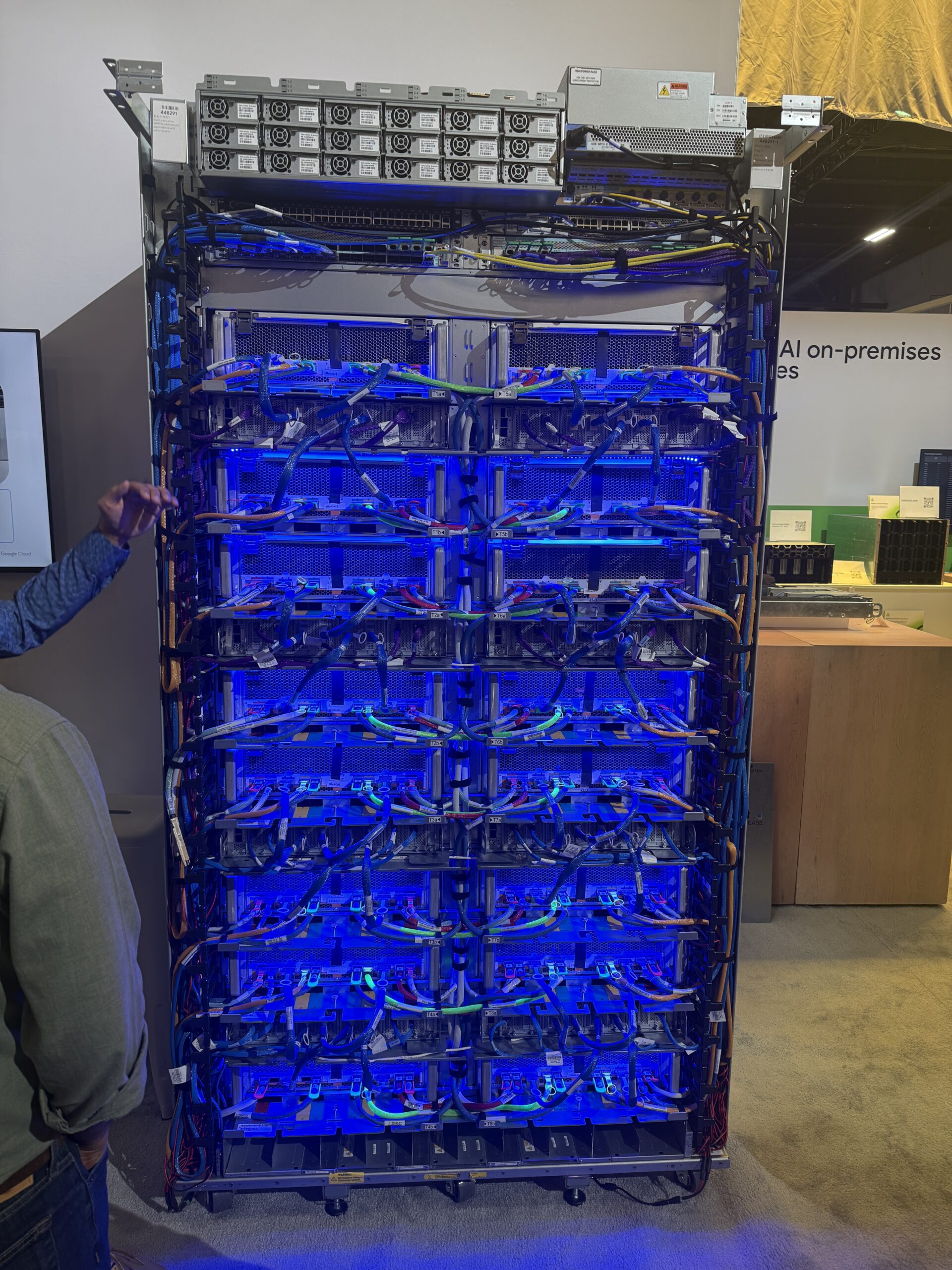Gemini Flash: Google’s AI Edge Play Delivers for Security-Conscious and Latency-Driven Enterprises
At Google Cloud Next, I sat down for a deep-dive discussion with Google Cloud Product Manager, Andrew Fetterer, that unlocked one of the most important AI infrastructure announcements of the show: Gemini Flash for Google Distributed Cloud (GDC). In short, this is a capability that puts the raw power of Google’s AI—specifically Gemini—into customer-controlled environments, with options for both cloud-connected and fully air-gapped deployments.
Suppose you’re in government, healthcare, financial services, or even commercial sectors like biotech or retail with sensitive or latency-sensitive workloads. In that case, Gemini Flash might be the most relevant product you’re not paying enough attention to.
Let’s break it down.
Air-Gapped AI: When Your Data Can’t (and Shouldn’t) Leave the Building
Air-gapped infrastructure is nothing new in the enterprise, but enabling modern AI within those environments? That’s an entirely different ballgame.
With Gemini Flash for GDC, Google is offering a truly air-gapped solution for customers whose data absolutely cannot leave their premises. This is delivered either as a pre-engineered appliance or via software that customers deploy on approved hardware—typically Nvidia’s HGX or DGX-class systems. These are not just boxes with Tensor cores; they are clusters purpose-built to run Google’s control plane, AI models, and edge services.
When deployed in air-gapped mode, there is no dependency on a public cloud control plane. That means no outside call-outs, no persistent connections back to Google. You get full-stack inference and AI application hosting capabilities behind your own firewall, in your own physically secure facility. For national security, healthcare diagnostics, or other sensitive use cases, this is exactly the kind of AI deployment architecture that’s been missing from the market.
Even though it’s air-gapped, you don’t lose the ease of Google Cloud-native development. Customers still have access to key services like GKE and Gemini APIs within the scope of the cluster. This is not a watered-down version of GCP—it’s a curated, high-assurance version engineered for private deployment.
AI at the Edge: Because Latency Still Matters
Security and data sovereignty are not the only reasons to keep AI close to the source. Latency is a non-negotiable in many real-time or near-real-time applications.
Here’s a practical scenario: Imagine a biotech research firm generating petabytes of genomics data from on-site sequencing. Uploading that volume of data to the public cloud is cost-prohibitive and functionally impossible within the desired time window. However, researchers still need to run AI inference, model gene sequences, detect mutations, and cross-reference historical datasets. With Gemini Flash, the model comes to the data. Local inferencing happens with cloud-native development paradigms, enabling developers and data scientists to iterate without ever worrying about moving massive data sets upstream.
This is a textbook example of why cloud-managed AI at the edge isn’t just a security workaround—it’s a performance necessity.
How Small Can You Go? The Form Factor Advantage
One of the most compelling features of the Gemini Flash implementation is its flexibility in physical deployment.
-
A retail deployment might involve a 1U server sitting behind the customer service counter in a broom closet, enabling real-time loss prevention via computer vision.
-
A rugged mobile unit might live in a remote oil rig or a forward-operating base, surviving intermittent connectivity while running Gemini-powered workflows.
-
In more traditional enterprise settings, customers can scale up to full racks in their data centers and dedicate those to high-throughput AI operations, inference pipelines, and even real-time search across proprietary datasets.
This “scale-to-fit” approach is a differentiator. From the far edge to the full data center, Gemini Flash molds to your environment.
Pricing and Subscription Model: Predictable, Not Punitive
One of the key friction points in edge AI adoption has been unpredictable pricing. Whether you’re burning through GPU tokens or spinning up and down instances based on fluctuating demand, AI in the cloud can feel a bit like watching a taxi meter on steroids.
Google’s approach with Gemini Flash is refreshingly straightforward.
Customers pay for a fixed subscription that includes the infrastructure (if bundled) and the software stack. That means predictable costs—even in air-gapped deployments. You don’t pay per token. You’re not billed based on spikes in usage. You buy the system and run it as much or as little as you want within its physical and architectural limits.
This model gives enterprise procurement teams peace of mind. There’s a built-in lifecycle model as well: when new GPU generations or AI service layers become available, you can expand your cluster or refresh nodes without overhauling the entire environment.
Agent Space and Data Governance: The Enterprise Lens
Google is also implementing thoughtful enterprise access controls through Agent Space. While only a subset of Agent Space capabilities (starting with search) is available on GDC today, Google clearly plans to extend that further.
Enterprise users can ingest their data through connectors and build private, role-aware search agents. These agents can respect fine-grained access control across different systems—whether that’s Active Directory groups, ERP data permissions, or even custom RBAC mappings within your file systems.
That’s a big win for regulated industries, where a business analyst might need to search across datasets but shouldn’t be able to see sensitive HR or financial records.
Final Thoughts: AI Without Compromise
Gemini Flash makes it clear: cloud AI and enterprise-grade infrastructure are no longer mutually exclusive. You can get the benefit of Google’s cutting-edge LLMs, developer ecosystems, and agent orchestration—without compromising on data location, security, or latency.
Whether you’re securing an air-gapped environment for government work or trying to minimize TCO and time-to-answer on petabyte-scale datasets in life sciences, Gemini Flash brings cloud-scale intelligence where it’s needed most: to your environment.
This isn’t just edge AI. This is enterprise edge AI done right.
—
What’s your take? Are you exploring air-gapped AI or looking for ways to get cloud-native developer velocity closer to your data? Hit me up or share your experience using #CTOAdvisor.
Share This Story, Choose Your Platform!

Keith Townsend is a seasoned technology leader and Chief Technology Advisor at Futurum Group, specializing in IT infrastructure, cloud technologies, and AI. With expertise spanning cloud, virtualization, networking, and storage, Keith has been a trusted partner in transforming IT operations across industries, including pharmaceuticals, manufacturing, government, software, and financial services.
Keith’s career highlights include leading global initiatives to consolidate multiple data centers, unify disparate IT operations, and modernize mission-critical platforms for “three-letter” federal agencies. His ability to align complex technology solutions with business objectives has made him a sought-after advisor for organizations navigating digital transformation.
A recognized voice in the industry, Keith combines his deep infrastructure knowledge with AI expertise to help enterprises integrate machine learning and AI-driven solutions into their IT strategies. His leadership has extended to designing scalable architectures that support advanced analytics and automation, empowering businesses to unlock new efficiencies and capabilities.
Whether guiding data center modernization, deploying AI solutions, or advising on cloud strategies, Keith brings a unique blend of technical depth and strategic insight to every project.




